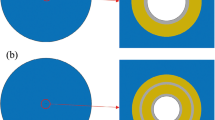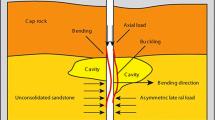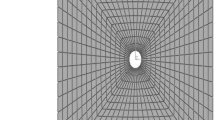Abstract
In this paper, we present an analytical method for evaluating the stress field within a casing-cement-formation system of oil/gas wells under anisotropic in-situ stresses in the rock formation and uniform pressure within the casing. The present method treats the in-situ stresses in the formation as initial stresses since the in-situ stresses have already developed in the formation before placement of cement and casing into the well. It is demonstrated that, via this treatment, the present method excludes additional displacements within the formation predicted by the existing method, and gives more reasonable stress results. An actual tight-oil well is analyzed using the present and existing analytical methods, as well as the finite element method. Good agreement between the analytical results and the finite element analysis (FEA) results is obtained, validating the present method. It is also evident that, compared with the present method, the existing method overestimates the compressive stress level within the casing and the cement. Finally, the effects of elastic properties of the formation, cement, and inner pressure of casing on stresses within the casing and cement are illustrated with a series of sensitivity analyses.
Similar content being viewed by others
References
Vignes, B. and Aadnøy, B. S. Well-integrity issues offshore norway. SPE Production and Operations, 25, 145–150 (2010)
Boukhelifa, L., Moroni, N., James, S. G., Le Roy-Delage, S., Thiercelin, M. J., and Lemaire, G. Evaluation of cement systems for oil-and gas-well zonal isolation in a full-scale annular geometry. SPE Drilling and Completion, 20, 44–53 (2005)
Li, Z., Zhang, K., Guo, X., Liu, J., Cheng, X., and Du, J. Study of the failure mechanisms of a cement sheath based on an equivalent physical experiment. Journal of Natural Gas Science and Engineering, 31, 331–339 (2016)
Bois, A. P., Garnier, A., Galdiolo, G., and Laudet, J. B. Use of a mechanistic model to forecast cement-sheath integrity. SPE Drilling and Completion, 27, 303–314 (2012)
Bai, M., Sun, J., Song, K., Reinicke, K. M., and Teodoriu, C. Evaluation of mechanical well integrity during CO2 underground storage. Environmental Earth Sciences, 73, 6815–6825 (2015)
Bellabarba, M., Bulte-Loyer, H., Froelich, B., Le Roy-Delage, S., van Kuijk, R., Zeroug, S., Guillot, D., Moroni, N., Pastor, S., and Zanchi, A. Ensuring zonal isolation beyond the life of the well. Oilfield Review, 20, 18–31 (2008)
Dusseault, M. and Jackson, R. Seepage pathway assessment for natural gas to shallow groundwater during well stimulation, in production, and after abandonment. Environmental Geosciences, 21, 107–126 (2014)
Goodwin, K. J. and Crook, R. J. Cement sheath stress failure. SPE Drilling Engineering, 7, 291–296 (1992)
Fleckenstein, W. W., Eustes, A. W., III, and Miller, M. G. Burst-induced stresses in cemented wellbores. SPE Drilling and Completion, 16, 74–82 (2011)
Nabipour, A., Joodi, B., and Sarmadivaleh, M. Finite element simulation of downhole stresses in deep gas wells cements. SPE Deep Gas Conference and Exhibition, Society of Petroleum Engineerings, Manama, 1–13 (2010)
Philippacopoulos, A. J. and Berndt, M. L. Structural analysis of geothermal well cements. Geothermics, 31, 657–676 (2002)
Wong, R. C. K. and Yeung, K. C. Structural integrity of casing and cement annulus in a thermal well under steam stimulation. Journal of Canadian Petroleum Technology, 45, 6–9 (2006)
Ravi, K., Bosma, M., and Gastebled, O. Improve the economics of oil and gas wells by reducing the risk of cement failure. IADC/SPE Drilling Conference, Society of Petroleum Engineerings, Dallas, 1–13 (2002)
Bosma, M., Ravi, K., van Driel, W., and Schreppers, G. J. Design approach to sealant selection for the life of the well. SPE Annual Technical Conference, Society of Petroleum Engineerings, Houston, 1–14 (1999)
Gray, K. E., Podnos, E., and Becker, E. Finite-element studies of near-wellbore region during cementing operations: part I. SPE Drilling and Completion, 24, 127–136 (2009)
Salehabadi, M., Jin, M., Yang, J., Haghighi, H., Ahmed, R., and Tohidi, B. Finite element modeling of casing in gas-hydrate-bearing sediments. SPE Drilling and Completion, 24, 545–552 (2009)
Shahri, M., Schubert, J. J., and Amani, M. Detecting and modeling cement failure in highpressure/high-temperature (HP/HT) wells using finite element method (FEM). International Petroleum Technology Conference, Society of Petroleum Engineerings, Doha, 1–10 (2005)
Shen, Z. and Beck, F. E. Three-dimensional modeling of casing and cement sheath behavior in layered, nonhomogeneous formations. IADC/SPE Asia Pacific Drilling Technology Conference and Exhibition, Society of Petroleum Engineerings, Tianjin, 1–10 (2012)
Atkinson, C. and Eftaxiopoulos, D. A plane model for the stress field around an inclined, cased and cemented wellbore. International Journal for Numerical and Analytical Methods in Geomechanics, 20, 549–569 (1996)
Yuan, Z., Gardoni, P., Schubert, J., and Teodoriu, C. Cement failure probability analysis in water injection well. Journal of Petroleum Science and Engineering, 107, 45–49 (2013)
Thiercelin, M. J., Dargaud, B., Baret, J. F., and Rodriquez, W. J. Cement design based on cement mechanical response. SPE Drilling and Completion, 13, 266–273 (1998)
Yin, Y. Q., Chen, Z. W., and Li, P. E. Theoretical solutions of stress distribution in casing-cement and stratum system (in Chinese). Aata Mechanica Sinica, 38, 835–842 (2006)
Li, B., Guo, B., Li, H., and Shi, Y. An analytical solution to simulate the effect of cement/formation stiffness on well integrity evaluation in carbon sequestration projects. Journal of Natural Gas Science and Engineering, 27, 1092–1099 (2015)
Li, Y., Liu, S., Wang, Z., Yuan, J., and Qi, F. Analysis of cement sheath coupling effects of temperature and pressure in non-uniform in-situ stress field. International Oil and Gas Conference and Exhibition in China, Society of Petroleum Engineerings, Tianjin, 1–8 (2010)
Wang, Y. B., Gao, D. L., and Fang, J. Assessment of wellbore integrity of offshore drilling in well testing and production. Journal of Engineering Mechanics, 142, 04016030 (2016)
Zhang, L., Yan, X., Yang, X., and Zhao, X. Evaluation of wellbore integrity for HTHP gas wells under solid-temperature coupling using a new analytical model. Journal of Natural Gas Science and Engineering, 25, 347–358 (2015)
Timoshenko, S. and Goodier, J. Theory of Elasticity, McGraw-Hill, New York, 55–81 (1951)
Papanastasiou, P. C. and Vardoulakis, I. G. Numerical treatment of progressive localization in relation to borehole stability. International Journal for Numerical and Analytical Methods in Geomechanics, 16, 389–424 (1992)
Salehi, S., Hareland, G., and Nygaard, R. Numerical simulations of wellbore stability in underbalanced-drilling wells. Journal of Petroleum Science and Engineering, 72, 229–235 (2010)
Volonte, G., Scarfato, F., and Brignoli, M. Sand prediction: a practical finite-element 3D approach for real field applications. SPE Production and Operations, 28, 95–108 (2013)
Author information
Authors and Affiliations
Corresponding author
Additional information
Project supported by the National Natural Science Foundation of China (Nos. 11502304 and 51521063) and the Science Foundation of China University of Petroleum (Nos.C201601 and 2462013YJRC023)
Rights and permissions
About this article
Cite this article
Liu, W., Yu, B. & Deng, J. Analytical method for evaluating stress field in casing-cement-formation system of oil/gas wells. Appl. Math. Mech.-Engl. Ed. 38, 1273–1294 (2017). https://doi.org/10.1007/s10483-017-2237-8
Received:
Revised:
Published:
Issue Date:
DOI: https://doi.org/10.1007/s10483-017-2237-8




